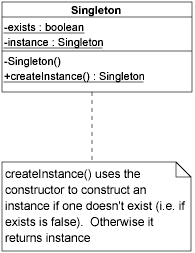|
The Singleton Pattern
An Introduction with Examples in Java |
|
Prof. David Bernstein |
| Computer Science Department |
| bernstdh@jmu.edu |
|
The Singleton Pattern
An Introduction with Examples in Java |
|
Prof. David Bernstein |
| Computer Science Department |
| bernstdh@jmu.edu |

FileViewer
/**
* A Frame that is used to view the contents of a file
*
* This class uses the Singleton pattern
* to ensure that there is only one
* instance at any point in time.
*
* @author Prof. David Bernstein, James Madison University
* @version 1.0
*
*/
public class FileViewer
{
private static boolean exists = false;
private static FileViewer instance;
/**
* Construct a new FileViewer
*
* Note: This method is private and used only internally
*/
private FileViewer()
{
exists = true;
}
}
FileViewer
/**
* Construct a new FileViewer (if one doesn't exist)
* or return the existing instance
*/
public static FileViewer createInstance()
{
if (!exists) instance = new FileViewer(); // exists will become true
return instance;
}
FileViewer
/**
* Handle valueChanged events
* (required by ListSelectionListener)
*
* @param lse The ListSelectionEvent to handle
*/
public void valueChanged(ListSelectionEvent lse)
{
FileViewer fv;
String fn;
fn = (String)list.getSelectedValue();
fv = FileViewer.createInstance();
fv.load(fn);
}
createInstance() method might
be called by multiple threads, problems can arisecreateInstance() synchronizedinstance
when it is declared)
private static FileViewer instance = new FileViewer();
/**
* Return the singleton instance
*/
public static FileViewer createInstance()
{
return instance;
}